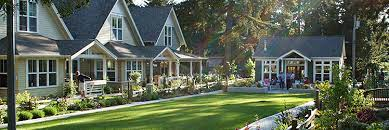When the Global Wellness Summit once again asked me to contribute to its annual Wellness Trends Report, my pitch may have seemed a bit out of my usual travel/ wellness wheelhouse. That said, the idea of writing about "New Wrinkles in Senior Living" evolved out of the work I have been doing for the past two years in the wellness real estate sector. On the face of it, it's a subject matter that may seem to have limited appeal. But in actuality, as the trend report is more about the value of intergenerational living, it's something young, old and everyone in between should read. Here's a teaser.
 |
| Click to Get the Full Report |
Summary: For years, it’s been said that 60 was the new 40. But now, according to leading aging experts, 90 will be the new 40 within a decade. The exponential jump in longevity means that people are retiring later, aging younger, and focusing on being active and engaged with self-care and personal growth into old age.
Healthier, more youthful, and more active than their cohorts in previous generations, this incoming senior class doesn’t “feel old” and doesn’t want to be defined by age, nor socially segregated by it. That’s why today’s age-segregated models of senior living communities are no longer cutting it with a new generation that doesn’t believe in the concept of being put out to pasture upon retirement.
To meet the changing expectations of aging adults, we believe “senior living” (a term that we would like to see retired) needs to focus more on intentional intergenerationality. This goes back to days of yore, when people were not so transient and communities stayed organically intergenerational. Such old-school intersectionality still exists in the world’s Blue Zones, places like Okinawa, Japan and Sardinia, Italy, which also happen to be among the places where people live the longest and age the healthiest.
 |
| A multigenerational family living in the Blue Zone of Sardinia, Italy (franoi.com) |
In this trend report, we examine new models for intergenerational living, environments that can set the stage for reducing age segregation, while increasing social connections and decreasing loneliness, which is an epidemic at this point. These new models have great potential for resulting in better health and wellbeing outcomes for all residents. We look at the development of pocket neighborhoods, innovative mutually-beneficial intergenerational co-living models, and strategies for designing for intergenerationality. These new models have great potential for resulting in better health and wellbeing outcomes for residents of all ages.
 |
| An example of pocket neighborhood design |
Let’s point out that this concept of intergenerational housing goes beyond brick and mortar. There’s an overall ethos involved, in which a community is intentionally designed so that people of all ages have multiple opportunities for connection, collaboration and friendship. To meet this objective, a community must allow people of different ages to live side by side as good neighbors, so that they can share their talents and resources, develop relationships and provide mutual support.
 |
Trend Introduction: They say that everything old becomes new again and so it seems to be going with the concept of so called “senior living” (a term that, frankly, we would like to see retired).
In days of yore, neighborhoods and communities were organically intergenerational. People rarely moved away from the community in which they spent their adulthood. Every kid on the block knew each other and grandparents often lived with their descendants. This idea of intergenerational intersectionality still exists in the world’s Blue Zones, places like Okinawa, Japan, and Sardinia, Italy, which also happen to be among the places where people live the longest.
However, in many industrialized countries, the days of yore ended with the rise of suburbia. Cue developer Del Webb, who introduced the now stereotypical version of a retirement community back in 1960. Webb pioneered the active adult concept, a self-sustaining ecosystem filled with amenities like pools, parks and dining areas, with the opening of Sun City in Arizona. Its success led Webb to replicate the concept in warm weather destinations across the US throughout the next few decades.
 |
| This is senior living at Del Webb (image courtesy Del Webb) |
Due to the popularity of Webb’s projects, standard home builders started getting into the act by the mid-1970s. They began designing active adult com munities, age-segregated developments that included amenities like fitness centers, walking trails, swimming pools and social clubs. Not only were these places age-segregated, but they were usually geographically segregated as well. To live in this type of community, people often had to move far away from where they spent most of their adult life.
 |
| Credit: lifeover50.net |

No comments:
Post a Comment